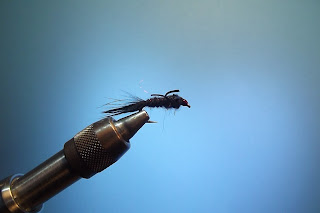When I first met Nikki, I didn't know anything about fishing. My sole experience with fishing was
summers at the neighbor's lakeside vacation home, feet dangling off the dock, and someone
braver than I handing me a fishing pole with the worm already on the hook. And those rare times
some poor little bluegill happened to actually eat my worm, the pole would be handed over to
that braver person to remove the fish. I'm inclined to say we killed those fish and an adult cooked
them, but I have no clear memory of that. But I didn't know there was an alternative to killing
them, so we must have.
In the last decade, my fish-sense has grown exponentially. First of all, I know it's a rod, not
a pole. And I know that worms are not the only type of bait. In fact, I've absorbed enough
information about artificial flies that I can name many of them on sight, recognize materials, and
even identify the type of fish it can catch. Sometimes. But that's not bad considering I still don't
actually like fishing.
I'll tell you what I do like, though. Eating fish. When my freezer's empty, I ask Nikki to bring home
a freshly caught fish, visions of fish pie or fish-n-chips dancing in my head. And this has actually
led me to learn about fish preservation.
I've learned about catch-and-release. I've learned that in some regions, catch-and-release is THE
rule of fishing, while in other regions catch-and-release is seemingly an unknown concept, and
I've learned about the shades of gray between those two catch-and-release camps.
I now know that when she tells me about a pig of a fish she caught, if I actually speak the
words that pop into my head unchecked -- "Why didn't you kill it and bring it back for dinner?" -
- the answer I'll get is "Never keep the big fish." The big ones are the ones who have proven
themselves, have spawned the most, have survived the longest and have contributed the most to
our fisheries. They're wily; they know how to avoid getting caught. They'll go on to live many more
years and produce many more fish. And besides, their meat isn't so tasty.
When she tells me about the little fish that she threw back in, I know why she didn't bother saving
them. Besides the math involved -- one little fish won't even feed one hungry person -- this little
fish has a long life ahead of it, during which it will spawn many, many times, repopulating the
waters so there will be many years of good fishing ahead.
And when she shows me the medium-sized fish she caught and brought home and tells me
about all the others she put back, I know well enough not to ask why she only brought one. We
don't need to be greedy. We should only kill what we know we'll eat. If we killed something and
then didn't eat it, it's a senseless kill. So one fish at a time, and it gets frozen carefully, often in a
water-filled bag -- a different type of fish preservation -- so it doesn't get freezer burned before it's
dinner.
And during spawning season? Forget it. There's no way she'd kill a fish during spawning season.
It's too short-sighted. Why kill a fish who was potentially just about to make thousands of more
fish for next year?
So my freezer waits for the perfect fish, caught at the perfect season. And when the stars align…
I get a perfect fish pie.
Fish Pie
- 2 lbs of fish (can be a mix; should be at least partly light fish like pollock)
- 4 cloves of fresh garlic crushed and chopped fine
- 2 teaspoons of salt
- Dash of pepper
- Dash of Hungarian paprika
- 1 bay leaf
- Handful of parsley
- 2 carrots chopped
- 2 large onions chopped
- 1 cup of peas
- 4 tablespoons olive oil
- Milk or half & half
- 3 tablespoons corn flour or tempura flour
Mashed potatoes
- 4-6 large potatoes
- 2 tablespoons butter
- 2 teaspoons of salt
- Dash of pepper
- Parsley
- 2 crushed garlic cloves
In a pot sauté the onion and half of the parsley in the olive oil. Once the onions are translucent
add the fish and all of the spices and continue to sauté for another minute. Add the carrots and
the milk (or half & half), enough to cover the fish. Bring to a near boil then simmer for half hour.
Peel and chop the potatoes and place them in a pot of boiling water for approximately 10
minutes. Once they are soft, strain the water, add salt and pepper, butter and beat with a mixer to
make mashed potatoes. Set aside.
Strain about a cup of the milk from the fish mixture and add in the corn flour and mix it until it
forms a paste then add it to the pot and stir until it thickens. Once it has thickened, pour the
mixture into a deep baking dish and cover the top with the mashed potatoes. Sprinkle parsley,
paprika and garlic on the mash and bake for 30 to 40 minutes or until golden brown at 350°F







.JPG)
.JPG)

